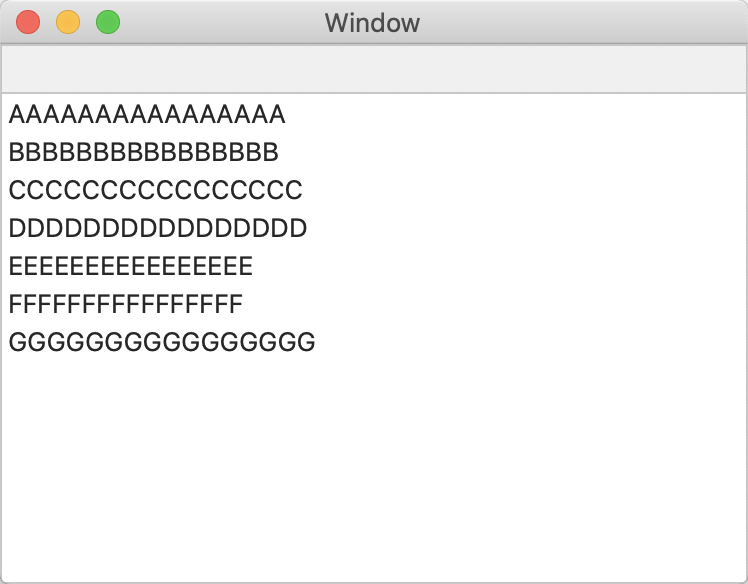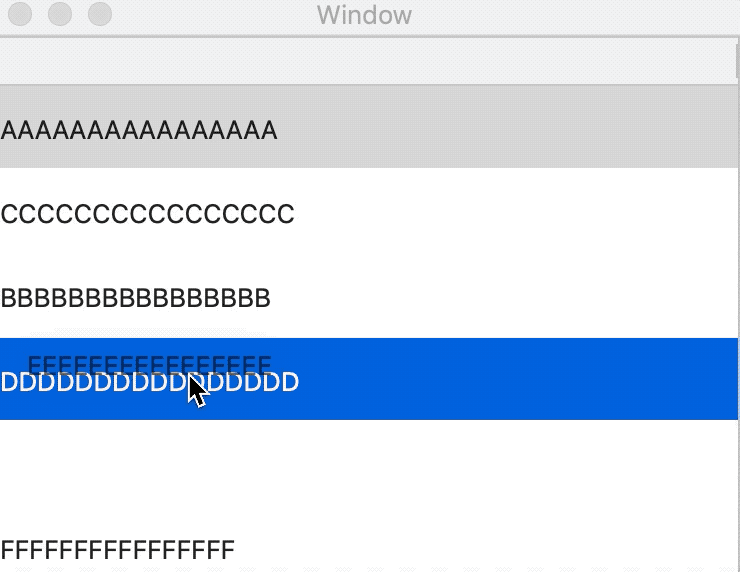Cocoa开发 - 对NSTableView进行拖拽排序
NSTableView
定义数据源
private var dataSource: [String] = [
"AAAAAAAAAAAAAAAA",
"BBBBBBBBBBBBBBBB",
"CCCCCCCCCCCCCCCC",
"DDDDDDDDDDDDDDDD",
"EEEEEEEEEEEEEEEE",
"FFFFFFFFFFFFFFFF",
"GGGGGGGGGGGGGGGG"
]
extension ViewController: NSTableViewDataSource, NSTableViewDelegate {
func numberOfRows(in tableView: NSTableView) -> Int {
return dataSource.count
}
func tableView(_ tableView: NSTableView, viewFor tableColumn: NSTableColumn?, row: Int) -> NSView? {
let cell = tableView.makeView(withIdentifier: NSUserInterfaceItemIdentifier("CELL"), owner: self) as? NSTableCellView
cell?.textField?.stringValue = dataSource[row]
return cell
}
}

设置 draggingDestinationFeedbackStyle为gap就能实现。
拖拽实现排序
首先得定义拖拽的粘贴板类型:
let dragType = NSPasteboard.PasteboardType("test.data")
override func viewDidLoad() {
super.viewDidLoad()
tableView.registerForDraggedTypes([dragType])
}
然后实现NSTableViewDataSource中的如下几个方法:
func tableView(_ tableView: NSTableView, writeRowsWith rowIndexes: IndexSet, to pboard: NSPasteboard) -> Bool
func tableView(_ tableView: NSTableView, validateDrop info: NSDraggingInfo, proposedRow row: Int, proposedDropOperation dropOperation: NSTableView.DropOperation) -> NSDragOperation
func tableView(_ tableView: NSTableView, acceptDrop info: NSDraggingInfo, row: Int, dropOperation: NSTableView.DropOperation) -> Bool
- 方法一主要将拖动的行(可能是多行)写到粘贴板中
- 方法二在拖拽结束的时候判断这是不是一个合法的Drop
- 方法三就是处理Drop了
func tableView(_ tableView: NSTableView, writeRowsWith rowIndexes: IndexSet, to pboard: NSPasteboard) -> Bool {
let data = NSKeyedArchiver.archivedData(withRootObject: rowIndexes)
let item = NSPasteboardItem()
item.setData(data, forType: dragType)
pboard.writeObjects([item])
return true
}
接着
func tableView(_ tableView: NSTableView, validateDrop info: NSDraggingInfo, proposedRow row: Int, proposedDropOperation dropOperation: NSTableView.DropOperation) -> NSDragOperation {
guard let source = info.draggingSource as? NSTableView, source == tableView else {
return []
}
if dropOperation == .above || dropOperation == .on {
return .move
}
return []
}
最后处理Drop信息,将 NSDraggingInfo 中的信息反序列化为索引,对数据源和TableView进行操作。
func tableView(_ tableView: NSTableView, acceptDrop info: NSDraggingInfo, row: Int, dropOperation: NSTableView.DropOperation) -> Bool {
let pb = info.draggingPasteboard
if let itemData = pb.pasteboardItems?.first?.data(forType: dragType),
let indexes = NSKeyedUnarchiver.unarchiveObject(with: itemData) as? IndexSet {
for index in indexes {
(dataSource[index], dataSource[row]) = (dataSource[row], dataSource[index])
tableView.moveRow(at: index, to: row)
}
return true
}
return false
}
实现类似Dock拖拽排列的效果
Dock 上面的图标在拖拽排列的时候有一个挤占效果,其实只要设置一个tableView的属性即可。
override func viewDidLoad() {
super.viewDidLoad()
tableView.registerForDraggedTypes([dragType])
tableView.draggingDestinationFeedbackStyle = .gap
}
